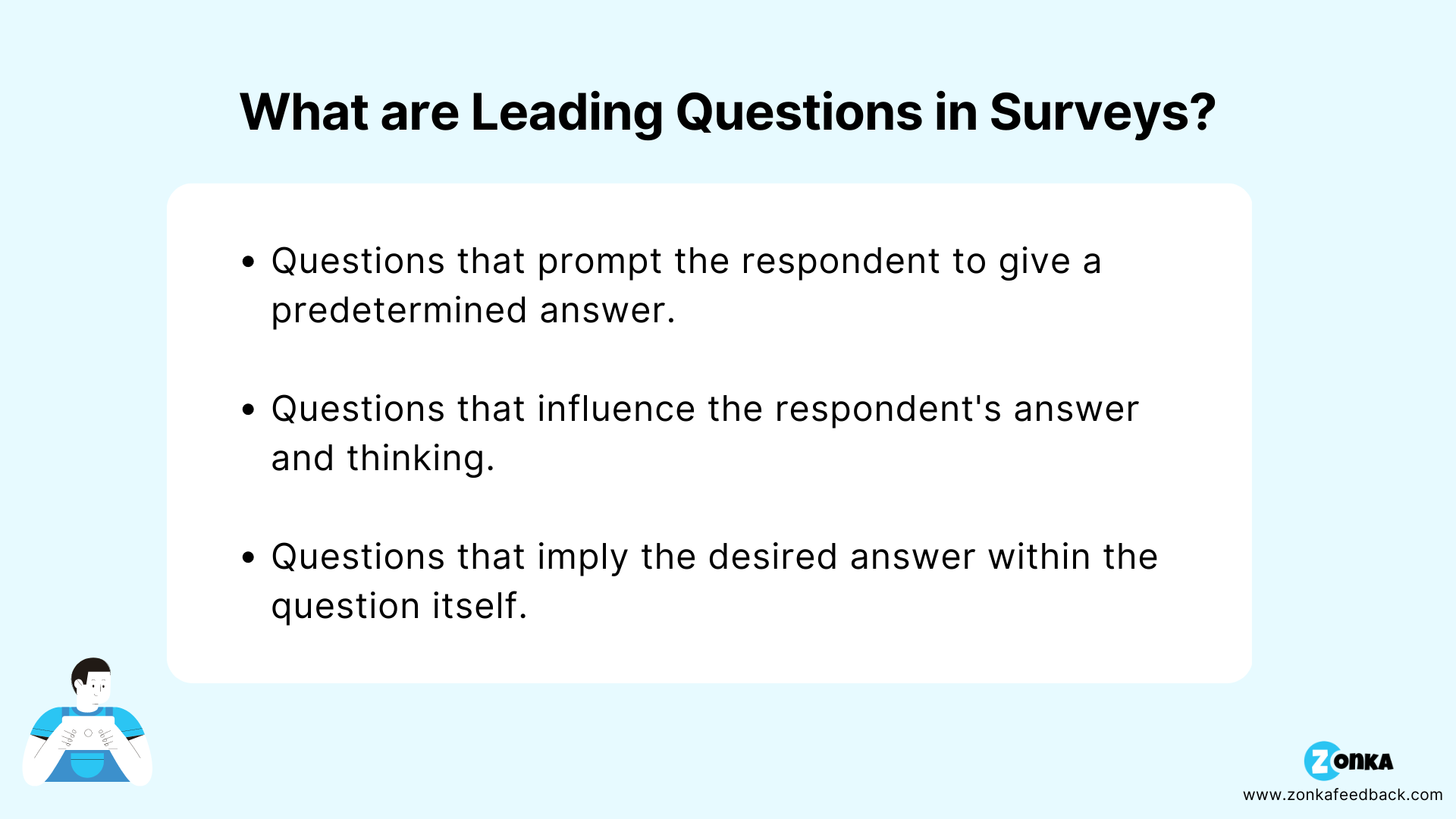As a survey creator or business owner it's important to not just collect data, but also make sure that it's accurate and unbiased. And therefore, it's crucial to avoid leading questions in your surveys.
In everyday conversation, we often ask questions to gather information, express interest, or engage with others. However, not all questions are created equal. Some questions can unintentionally lead people to answer in a certain way or influence their responses. These are known as leading questions, and they can have a significant impact on the accuracy and validity of the information we receive. Asking such questions in your survey lead to misleading data and bad business decisions from your survey programs.
Leading questions can distort responses, undermine credibility, and ultimately lead to poor decision-making. In this blog, we'll discuss what leading questions are, why they're problematic, and provide practical tips for avoiding them while creating your surveys.
Table of Contents
- What are Leading Questions?
- Different Types of Leading Questions
- Examples of Leading Questions
- Why are Leading Questions Problematic?
- How to Avoid Leading Questions?
What are Leading Questions?
A Leading Question is a survey question that suggests a particular answer or influences the respondent to answer in a certain way. Leading questions can be subtle or overt, but their intent is to shape the response of the person being asked. For example, "Don't you think the new policy is a bad idea?" is a leading question because it assumes that the respondent thinks the new policy is a bad idea.
Sometimes leading questions are intentional and stem from the survey creators bias, looking to persuade the respondents to answer in a certain way to gain certain specific responses. For instance, Do you think our product is the best choice for your needs? How satisfied are you with the high quality service provided here?
In contrast, some leading questions may be included in your survey by accident and with small tweaks can easily be fixed to ensure the integrity of the survey and data.

Different Types of Leading Questions & Examples
There are many different types of leading questions, and it's important to know about them to avoid them intentionally or unintentionally in the surveys and ensure the authenticity of the data being captured. Let's take a look at the different types of Leading Questions and a few examples.
1. Biased Leading Questions
Biased Questions are questions that contain language that favors one answer over another. They are loaded with assumption and are often found in customer experience surveys usually measuring customer perceptions about products, experiences or service.
Here are a couple of examples of Biased Questions.
- Do you agree that our company's products are the best on the market? (This question is a biased question because it assumes that the company's products are the best.)
- How much do you love the food here? (This question assumes that you love the food here.)
2. Presumptive Leading Questions
Presumptive Questions are questions that contain a presumption or assumption that may not be true.
Here are some examples of Presumptive Leading Questions.
- Do you plan to attend the conference, or are you not interested? (This is a presumptive question because it assumes that the respondent is either interested or not interested in attending.)
- Our team was really helpful with the onboarding, weren't they? (This question assumes
3. Direct Implication Leading Questions
Direct Implication Questions make the respondents consider the results that would happen based on a particular incident or event that may occur in the future. They are centered around the possibility of occurrence of some mentioned event, and coerce the respondents to base their answers on the perception.
Here are some example of a Direct Implication Leading Question:
- If the event gets you more leads, you would like to participate again?
- If you enjoy working here, would you recommend this to your friends and family?
- If you enjoy dining here, would you share a review online?
4. Tag Leading Questions or Interconnected Statements
These are questions that are added onto the end of a statement and may lead the respondent to agree or disagree. It often confuses the respondent by making a statement as a fact and then asking a question based on the statement.
For example,
- The new policy is a good idea, isn't it? (The statement in this question assumes that the policy is a good idea.)
- Most of your colleagues want to come back to office and work from here. Do you?
5. Double-Barreled Questions
Double-Barreled questions are the ones that ask about more than one topic or issue at once. For example, "Do you think our product is of high quality and reasonably priced?" is a double-barreled question because it asks about both quality and price. Interconnected, double-barreled questions like these reduce the clarity of the question itself and lead to inaccurate responses. In this case, for example, the respondent may feel that the product is high quality but not necessarily reasonably priced.
Loaded Questions
These are questions that contain emotionally charged language or suggest a particular answer. While these are not typically leading questions, they can be considered so as they do lead to bias in the mind of the respondent and lead them to answer based on the bias.
Here are a few examples of Loaded Questions:
- Don't you think it's unethical to cut funding for public schools? (This is is a loaded question that assumes the respondent thinks it's unethical.)
- Isn't hybrid model of working better as it allows you to meet your colleagues often?
By being aware of these different types of leading questions, you can avoid unintentionally including them in your surveys and gather more accurate and unbiased data. Instead, focus on asking open-ended and neutral questions that allow respondents to provide their own answers without being influenced by the wording of the question.
Examples of Leading Questions
Let's check out some examples of Leading Questions in different industries and use cases.
Leading Questions in Sales
Business Development Teams and Sales persons send leading questions very often in their emails and conversations to persuade perspective clients and customers to buy or subscribe to their products.
- When would you like to get started with your subscription? (assumes that the respondent is interested in the subscription)
- When can I schedule a meeting with you? (assumes that the respondent is interested in the meeting)
Leading Questions in Hospitality & Restaurants
- If you liked your meal, would you come back again soon?
- If you liked your stay, would you recommend this hotel to others?
- If you liked your stay here, would you give us a review online?
Leading Questions in Legal
Lawyers ask leading questions to nudge the case in certain direction.
- How angry were you with the victim that day? (assumes that the defendant was angry with the victim)
- How late were you able to reach home that night? (assumes that the person came late that night)
- How much desperately you wanted to take revenge from the victim? (leads the case in the direction that the defendant wanted to take revenge)
Let's explore why Leading Questions are problematic rather than being useful to derive meaning information.
Why are Leading Questions Problematic?
Leading questions can be problematic for several reasons. Let's read them below.
1. Leading Questions lead to Inaccurate Information
If someone is influenced to answer in a certain way, the response may not reflect their true opinion or experience. This is problematic in all kinds of surveys and feedback forms like customer experience, feedback, research, where accurate and unbiased opinion and data is crucial.
This inaccurate or false information can lead you to base your business decisions on facts that are biased and may lead to harm to the business. And honestly, inaccurate data is of no use to your business.
2. Leading Questions can be unethical
If someone is intentionally led to answer in a particular way, it can be seen as a form of coercion or manipulation. This is particularly true in legal settings, where leading questions can be used to elicit false testimony.
3. Leading Questions can damage Trust and Credibility
As a customer or respondent, it is important to not feel manipulated or pressured to answer in a certain way. When feeling manipulated, the customer is likely to start trusting the person lesser. For example, after a doctor's appointment, if a patient receives a feedback form with questions like 'The doctor did a great job at diagnosing your problem, didn't he?', you are likely to feel that the healthcare center is coercing a positive answer from you and you may not trust going back there again.
4. Leading Questions don't give any new information
When measuring customer feedback, seeking customer service experience or product feedback, asking leading questions may amp up your CX metrics but would give you no valuable information or new information to actually help the business. The insights would be misleading and non-actionable as you have led the customers to give the answers you wanted to hear with leading questions.
Since Leading Questions do more harm then good, it is very important to avoid them while creating your survey. Let's learn more about it.
How to Avoid Leading Questions?
To avoid leading questions, it's important to be aware of the language you use when asking questions. Here are some tips:
1. Ask Open-Ended Questions
Instead of asking questions that suggest a particular answer, ask open-ended questions that allow the respondent to provide their own answer. For example, "What are your thoughts on the new policy?" is an open-ended question that allows the respondent to provide their own perspective.
2. Avoid Loaded Language
Loaded language is language that is emotionally charged or has a particular connotation. Avoid using language that suggests a particular answer or elicits a particular emotional response. For example, "Don't you agree that the new policy is terrible?" is a leading question that uses loaded language.
3. Be Neutral
When asking questions, try to be as neutral as possible. Avoid expressing your own opinion or using language that suggests a particular answer. For example, "What do you think about the new policy?" is a neutral question that doesn't suggest a particular answer.
4. Consider the Context
The context in which a question is asked can also influence the response. Consider the setting, the relationship between the person asking the question and the respondent, and any other relevant factors.
Conclusion
In conclusion, it's important that while creating surveys, leading questions are avoided as they can have significant impact on the accuracy and validity of the surveys and feedback forms. All options should be stated clearly, respondents should be given all options and choices and also an option to not answer the question or choose another option. To avoid leading questions, it's important to be aware of the language used when asking questions and to strive for neutrality and openness. By doing so, survey creators can ensure that they receive accurate and unbiased information, and maintain trust and credibility with the customers and respondents who they interact with.











